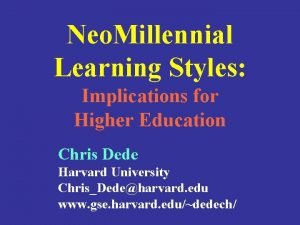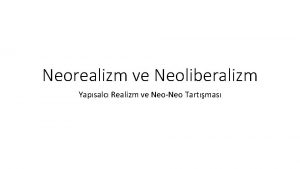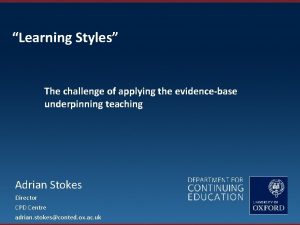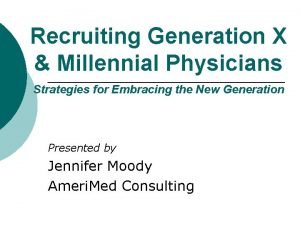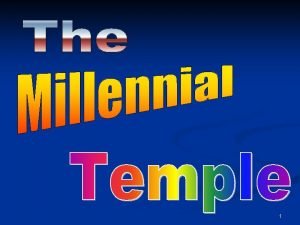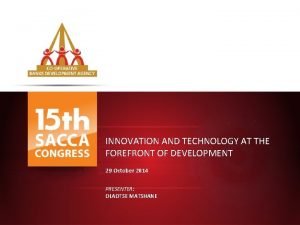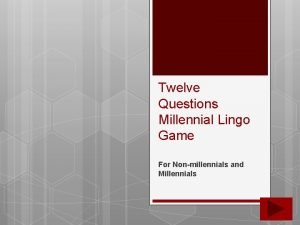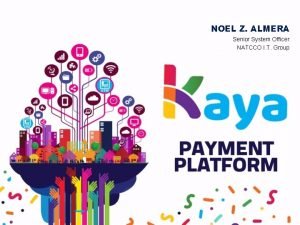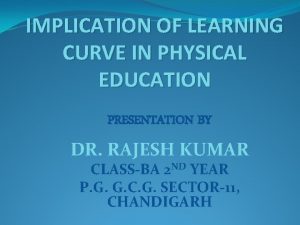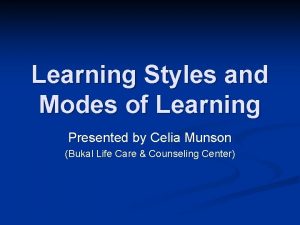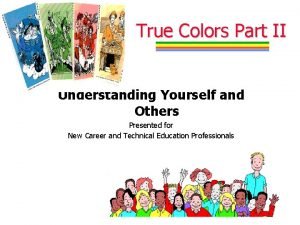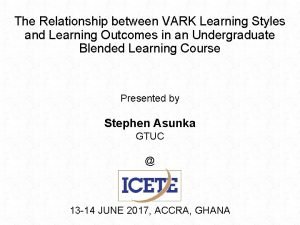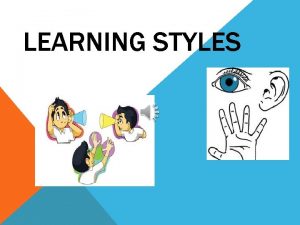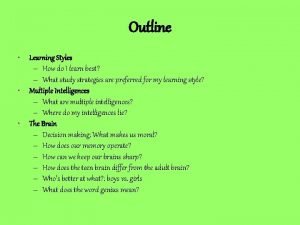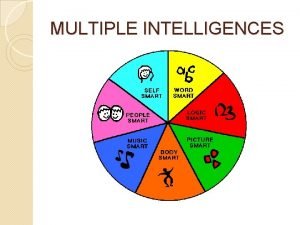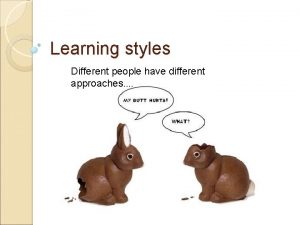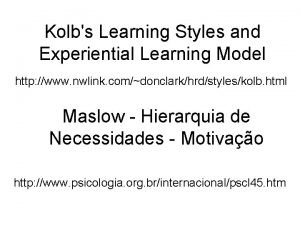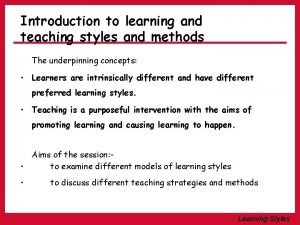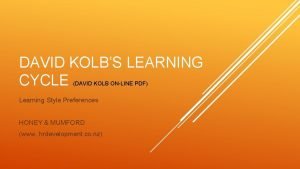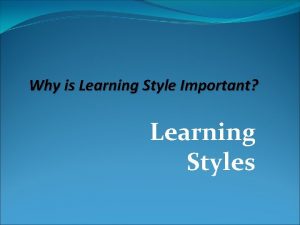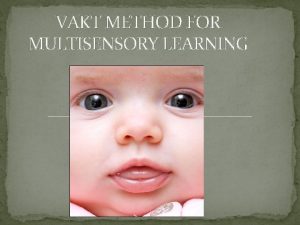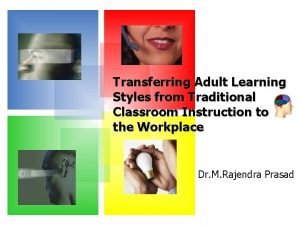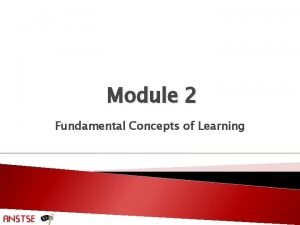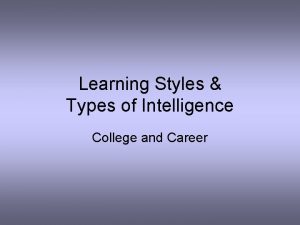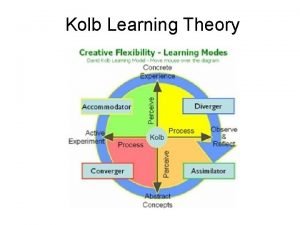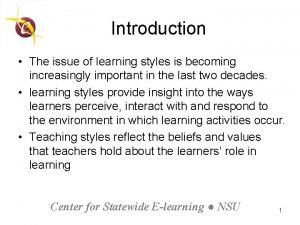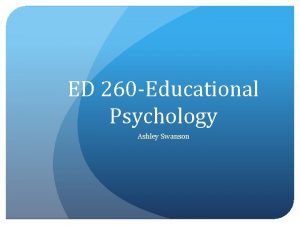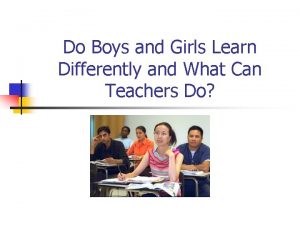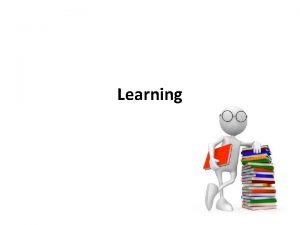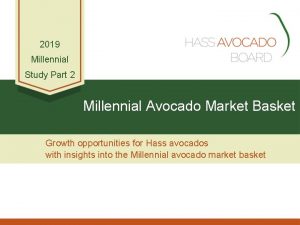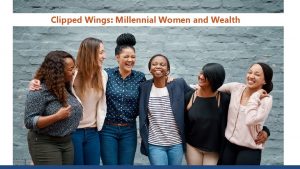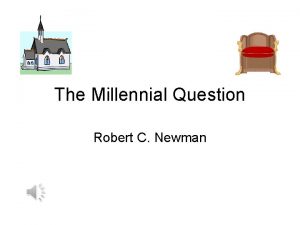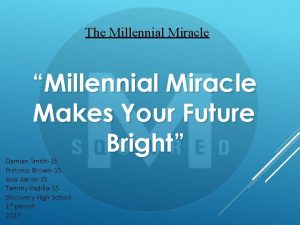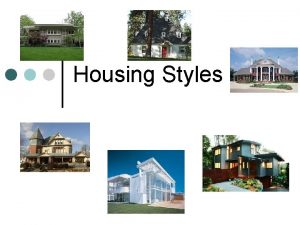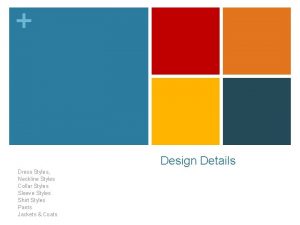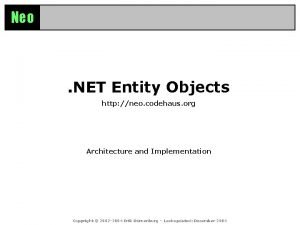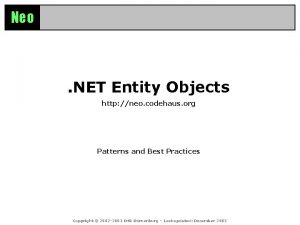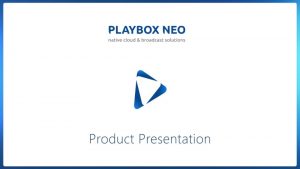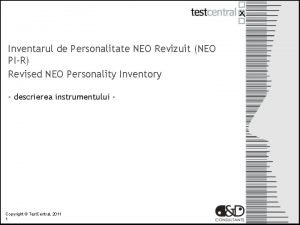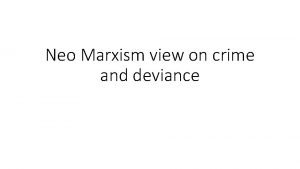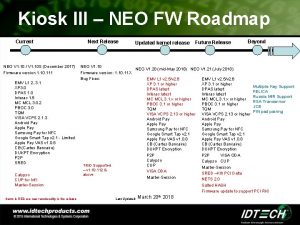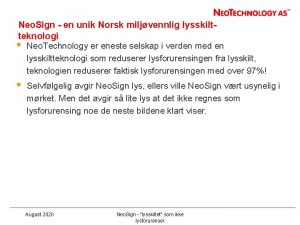Neo Millennial Learning Styles Implications for Higher Education


































- Slides: 34

Neo. Millennial Learning Styles: Implications for Higher Education Chris Dede Harvard University Chris_Dede@harvard. edu www. gse. harvard. edu/~dedech/

The Evolution of Education • shifts in the knowledge and skills society values • development of new methods of teaching and learning • changes in the characteristics of learners emerging information technologies are reshaping each of these

“Learning Styles” Ø Sensory-based Ø Visual, auditory… Ø Personality-based Ø Myers-Briggs… Ø Aptitude-based Ø Multiple Intelligences Ø Media-based

Media Shape Their Participants Regardless of Age “Millennial” Learning Styles- I 1) Web rewards comparing multiple sources of information, individually incomplete and collectively inconsistent (mindlessly accumulating or seeking, sieving, synthesizing) 2) Digital media and interfaces encourage multi-tasking (superficial, easily distracted data gathering or a sophisticated form of synthesizing new insights)

“Millennial” Learning Styles -II Personalization and Customization 3) Customized services based on data-mining for personal characteristics and behaviors 4) “Napsterism”: recombining others’ designs to idiosyncratic configurations (Me + +, William Mitchell, ‘ 03)

Evolving toward Distributed Learning ü Sophisticated Methods of Learning and Teaching üGuided learning by doing üApprenticeships, mentoring üLearning communities ü Orchestrated across classrooms, homes, workplaces, community settings ü On demand, just-in-time ü Collaborative distributed across space, time, media

“Next Generation” Interfaces for Distributed Learning Ø World to the Desktop: Accessing distant experts and archives for knowledge creation, sharing, and mastery Ø Multi-User Virtual Environments: Immersion in virtual contexts with digital artifacts and avatar-based identities Ø Ubiquitous Computing: Wearable wireless devices coupled to smart objects for “augmented reality”

What is a MUVE? ü A representational container that enables multiple simultaneous participants to access virtual spaces configured for learning. ü A place where learners represent themselves through graphical avatars (persona) to communicate with others’ avatars and computer-based agents, as well as to interact with digital artifacts and virtual contexts. ü A learning experience that provides diverse activities in support of classroom curriculum.

Findings from Gaming Research Massively multi-player online games (MMOG) and complementary fan-fiction offer rich learning and identity formation, but peripherally linked to life Everquest game has 77 th largest economy; over 120, 000 fan-fictions online about Harry Potter

River City Curriculum Figure 1: Lab Equipment inside the University Figure 2: River Water Sampling

Added Features Microscope Movie

Findings from Our Research Ø enhancing motivation (challenge, curiosity, beauty, fantasy, fun, social recognition) Ø reaching learners who don’t do well in conventional classroom settings Ø learning both sophisticated content and higher order skills Ø building fluency in distributed modes of communication and expression -- rhetoric http: //muve. gse. harvard. edu/muvees 2003/

Powerful Pedagogical Models ü guided inquiry learning with active construction of knowledge ü apprenticeship/mentoring relationships ü collaborative learning: social exploration of multiple perspectives How People Learn (National Academy Press, 1999) http: //www. nap. edu/books/0309070368/html

Situated Learning • constellations of architectural, social, organizational, and material vectors that aid in learning culturally based practices – apprenticeship (the process of moving from novice to expert within a given set of practices) – legitimate peripheral participation (tacit learning similar to that involved in internships or residencies)

Learning Community A culture of learning, in which everyone is involved in a collective effort of understanding ü Shares and develops a repertoire of resources: experiences, tools, stories, ways of addressing recurring problems ü Allows a close connection between learning and doing ü Addresses the informal and tacit aspects of knowledge creation and sharing Within courses (lc-light) and in world (community of practice)

Distributed-Learning Communities ü Range of participants’ skills and interests goes beyond geographic boundaries ü Asynchronous media enable convenient participation and deeper reflection ü Emotional and social dimensions intensified by synchronous virtual interchanges ü Broader range of participants engage in dialogue Mediated, Situated Immersion

“Next Generation” Interfaces for Distributed Learning Ø World to the Desktop: Accessing distant experts and archives for knowledge creation, sharing, and mastery Ø Multi-User Virtual Environments: Immersion in virtual contexts with digital artifacts and avatar-based identities Ø Ubiquitous Computing: Wearable wireless devices coupled to smart objects for “augmented reality”

Ubiquitous Computing • One-to-one student to tool ratio • Wireless Mobile Devices (WMD) offer approximately 60% of the computing power of laptops of a few years ago (a WMD is approximately 10% of the cost of a modern laptop) • Wireless mobile computing – instant on, anytime, everywhere, and in the hand of the user “Smart objects” and “intelligent contexts” enable “augmented realities”

Emerging Digital Media May Pervade All Aspects of Life Ø MWDs access every type of data service anywhere (banking and stock market information, weather, tickets/reservations, transport schedules) Ø MWDs access data connected to locations (street signs linked to online maps), objects (books linked to online reviews), and locations (restaurants linked to ratings by their customers) Ø MWDs locate strangers nearby who have identified themselves as having common interests (friends of friends, fans of an actor or author) Rheingold, Smart Mobs (‘ 02); W. Mitchell, Me + + (’ 03)

Requisite Information Infrastructure is Emerging Ø One-third of U. S. households now have broadband access to the Internet. Ø In the past three years, 14 million U. S. families have linked their computers with wireless home networks. Ø Some 55% of Americans now carry cell phones Ø The first WMD data services--radio, photos, and short videoclips--are starting to take off

Augmented Reality Computer simulation on handheld computer triggered by real world location • Combines physical world and virtual world contexts • Embeds learners in authentic situations • Engages users in a socially facilitated context

Proof of Concept • Environmental Detectives – Players briefed about rash of local health problems linked to the environment – Provided with background information and “budget” – Need to determine source of pollution by drilling sampling wells and ultimately remediate with pumping wells – Work in teams representing different interests (EPA, Industry, etc. )

Drilling Wells • Choose – Sites to Sample – Sampling Methods • Influence budget, accuracy, and timeliness of samples Drill Wells Collect Samples Interpret Data

Conducting “Desktop” Research • Triggering of media events at specified locations – library → web documents – machine shop → video interviews with personnel

Harvard’s Ubiquitous Learning Project http: //gseacademic. harvard. edu/~hdul/ Many strategies apply to notebooks as well as handhelds

A Different Model of Pedagogy Ø Experiences central, rather than information as pre-digested experience (for assimilation or synthesis) Ø Knowledge is situated in a context and distributed across a community (rather than located within an individual: with vs. from) Ø Reputation, experiences, and accomplishments as measures of quality (rather than tests, papers)

“Neomillennial” Learning Styles 1) Fluency in multiple media, valuing each for the types of communication, activities, and expressions it empowers This goes beyond “millennial” learning styles, which center on working within a single medium best suited to one’s style and preferences

My Distributed Learning Course http: //www. gse. harvard. edu/~dedech/502/ q face-to-face interaction q videoconferencing q wireless, handheld devices q small group collaboration via groupware q synchronous interaction in virtual environment q asynchronous, threaded discussion q informal website-based learning experiences q shells for course authoring New Forms of Rhetoric

“Neomillennial” Learning Styles 2) Learning based on collectively seeking, sieving, and synthesizing experience, rather than individually locating and absorbing information from some single best source This goes beyond “millennial” learning styles in preferring reflective, communal learning via diverse, tacit, situated experiences over solo integration of divergent, explicit information sources

“Neomillennial” Learning Styles 3) Co-design of learning experiences personalized to individual needs and preferences This goes beyond “millennial” learning styles, which emphasize selecting a pre-customized variant from a range of services offered

Implications for Professional Development Ø Co-Design: Developing learning experiences students can personalize Ø Co-Instruction: Utilizing knowledge sharing among students as a major source of content and pedagogy Ø Guided Social Constructivism and Situated Learning: Infusing case-based participatory simulations into presentational/assimilative instruction Ø Assessment Beyond Tests and Papers: Using peer-developed and peer-rated forms of assessment

Meeting the Challenge of Transformation via “Unlearning” o Developing fluency in using emerging interactive media o Complementing presentational instruction with collaborative inquirybased learning o Unlearning almost unconscious assumptions and beliefs and values about the nature of teaching, learning, and schooling crucial issue for professional development

“Neomillennial” Mc. Luhan ØMedia shape their messages ØMedia shape their participants ØInfrastructures shape civilization

 Education styles
Education styles Neorealizm ve neoliberalizm arasındaki farklar
Neorealizm ve neoliberalizm arasındaki farklar Http://www.educationplanner.org
Http://www.educationplanner.org Retaining millennial physicians
Retaining millennial physicians Pre vs post millennial
Pre vs post millennial Millennial temple
Millennial temple Millennial disruption index
Millennial disruption index Shookt millennial meaning
Shookt millennial meaning Orointegratedcoop.com
Orointegratedcoop.com Learning curve in physical education
Learning curve in physical education Cuadro comparativo e-learning b-learning m-learning
Cuadro comparativo e-learning b-learning m-learning Modes of learning
Modes of learning Color personality test blue gold green orange
Color personality test blue gold green orange Vark inventory
Vark inventory Objectives of learning styles
Objectives of learning styles Outline learning styles
Outline learning styles Extracurricular activities
Extracurricular activities Kinesthetic learning style
Kinesthetic learning style Objectives of learning styles
Objectives of learning styles 7 learning styles and vark similarities
7 learning styles and vark similarities Kolbs learning styles
Kolbs learning styles Analytical amiable driver expressive
Analytical amiable driver expressive Why is knowing your learning style important
Why is knowing your learning style important Socioculturalism
Socioculturalism Kolb's learning cycle pdf
Kolb's learning cycle pdf Conclusion of learning styles
Conclusion of learning styles Vakt method
Vakt method Adult learning styles
Adult learning styles Thpes of learning
Thpes of learning Learning styles for career development
Learning styles for career development Kolb learning styles
Kolb learning styles Conclusion of learning styles
Conclusion of learning styles Learning styles and multiple intelligences
Learning styles and multiple intelligences Male vs female learning styles
Male vs female learning styles Vark.o
Vark.o
